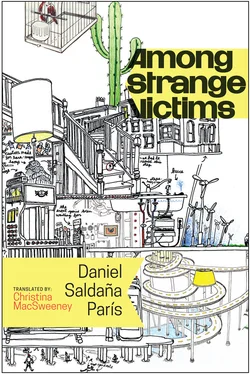Some months before, at the kiosk in the center of Los Girasoles, Jimmie had bought the tabloid he read religiously every Sunday. In a poorly written article, he had discovered that Dr. Mind was dead, and for that reason, he finally, after years of waiting, felt free to apply the CIA and E-Sight techniques of hypnosis for his own benefit. He had already made a few experiments, hypnotizing Central American prostitutes and queers garnered from the streets during his years of bumming about. Any mistake in the technique and the patient would wake up in the middle of the session, screaming and attempting to scratch his eyes out, but Jimmie had persevered until he had polished every detail and could now put even the most reluctant subjects into a trance. Once, he said, he had hypnotized a dog in Ciudad Juárez.
At some point in this hazardous form of amusement, Jimmie had, however, realized that Dr. Cameron’s method had certain applications unforeseen by its creator: doors that opened in the middle of the hypnosis that only an experienced therapist could enter without leaving his patient an idiot. Tunnels to unknown regions of the mind that Dr. Cameron had overlooked, concerned as he was with dragging a clumsy confession from a poor student or, later, from an employee who had attempted to take early retirement by selling a couple of formulae to the highest bidder. Jimmie’s ambitions were more expansive. He didn’t give a shit about the superficial layers of the consciousness, he said. What he was interested in was diving deeper, immersing himself in the gloomy depths of the frontal lobe.
At this point in the story, Jimmie’s voice became more serious. Even Micaela, usually so impassive, looked on edge, like a child waiting for the moment of opening the presents at a party. Velásquez had emerged from his profound meditation and, although he already knew the story, was staring spellbound at Jimmie. Marcelo Valente, trained in the toughest schools of philosophical reason, resisted the effects of the story, but didn’t deny the charm of the narrative, to which the gringo’s accent added an organic contribution.
The dramatic pause gave Jimmie the opportunity to serve another round of tequilas. Micaela continued to take timid sips from her can of beer, sitting on the floor on her pillows. Marcelo Valente glanced at her and for the first time understood her beauty. She wasn’t a child of eighteen; she was a very old woman, with the eyes of one who has seen things go up in flames too many times; she had regressed to her physiological age, thought Marcelo, from some unlikely place.
After downing his tequila in two swigs, Jimmie took up his narrative. Memory, he said, didn’t have a linear structure, as we used to imagine. Within it, all the images from our past were superimposed in a chaotic, random manner. The scenes shuffled together there were not the sediment of time but instantaneous constructions that could take in elements from any lived moment. Sometimes, said Jimmie, during a session of hypnosis, the patient’s images of a memory didn’t correspond to any previous lived experience. Among the family photos of a trip to the beach, a strange element would timidly sneak in, one that didn’t correspond to that or any other memory. They generally appeared in the form of an object — objects are traitorous: a piece of plastic, the function of which is hard to explain, or a gleaming white machine surrounded by rust. Jimmie termed those strange elements that appeared during hypnosis, falsifying the memories, “hypnotic fetishes.” And he had discovered, as he went on to add, that hypnotic fetishes were not imaginary constructions but anticipated future scenes that we would perhaps never see: kitchen appliances, toys our children or grandchildren would use quite naturally some Thursday morning, or multisensory sculptures that would make the visitors to future art galleries shudder. If, during the hypnosis, you managed to concentrate on those fetishes, you could learn about those future art forms and carry them into the present. That was, to cut a long story short, the project.
Marcelo, whose pragmatism had waned during his stay in Mexico and, in particular, during his recent conversations with Rodrigo, had listened with respect to the anecdotal part of Jimmie’s monologue: the intrigues with the CIA, the eighties, the counterespionage business, the financial disaster, the birth of the New Age, the illegal deals, the homosexual relationship between the budding fugitive from justice and the discredited psychiatrist, the betrayal and the flight south, the experiments with hypnosis. He adored the story. He had even thought, during a moment of distraction while Jimmie was rattling on, that he had to find a way to put some of it into his book, to relate it somehow with Foret’s months in Mexico and his disappearance. They’d lap this up in Madrid, he thought. They’d no longer see him as an academic with a talent for taking full advantage of the perks of the office, but as an authentic researcher of the passions of the soul, an explorer of the depths of consciousness who had, in the New World, discovered a parallel logic capable of renewing the stagnant thought of Western philosophy through the unlikely terrain of the aesthetics of madness. These were the delusions of grandeur he childishly gave himself up to from time to time on discovering, for example, an author no one had read. The idea of being a pioneer in some subject, of finding a bundle of yellowing papers in some provincial library that would position him as the man who was capable of rescuing some forgotten aspect of philosophical thought, stirred him to the core of his being. Shining in the pedestrian grayness of academia was such a complicated enterprise that he had dreams of himself as the Christ who would open the gates of a new conception of the world, and then all those miserable wretches would recognize his true worth.
Obviously, there was one aspect of Jimmie’s narrative that he was uneasy about: it was absolute nonsense. The belief that one could secretly look into a future art gallery to anticipate its content by a hundred years was enough to have the poor gringo locked away for life. He decided, nevertheless, to humor him and then later, when he got Velásquez alone, sound out the extent of Jimmie’s derangement.
Micaela stood up and went to fetch a glass from the dilapidated kitchen. Jimmie had his eyes fixed on Marcelo Valente, who was attempting to avoid the question that would inevitably follow.
“What do you think?” Jimmie eventually asked. “Do you want to join the project?”
Marcelo stammered feigned admiration and praised the gringo’s narrative talents. “But I’m not sure,” he then said, “what all this has to do with me.”
Jimmie hit his brow with the palm of his hand, like someone who has remembered that he’s left the stove on three blocks from home. He took a deep breath and began a new monologue at the very moment Micaela returned to the room and sat cross-legged in her place, putting her empty glass down in front of her without having served another round of tequila to the others, as Marcelo imagined she would.
The thing was that the objectivity of the method, its ability to effectively predict or anticipate the future, depended not only on the hypnotist’s training and the willingness of the hypnotized subject, but also on confirmation by others of the content observed during hypnosis. That is to say: a fetish could be a fetish or it could be the fruit of the individual’s imagination, and only during a collective session of hypnosis, with everyone involved simultaneously diving into the future, or into the subconscious, or wherever the hell they were supposed to be diving, could the form of an unmistakably anticipatory object be defined. Everyone would search for the same fetish during the session and, given that they were intimately connected, thanks to the group exercises undertaken beforehand, the anticipatory potential of one member of the group would empower the other hypnotized subjects. On their return from the voyage, they would describe the object to each other, then they would proceed to construct a replica in clay or latex or whatever.
Читать дальше









